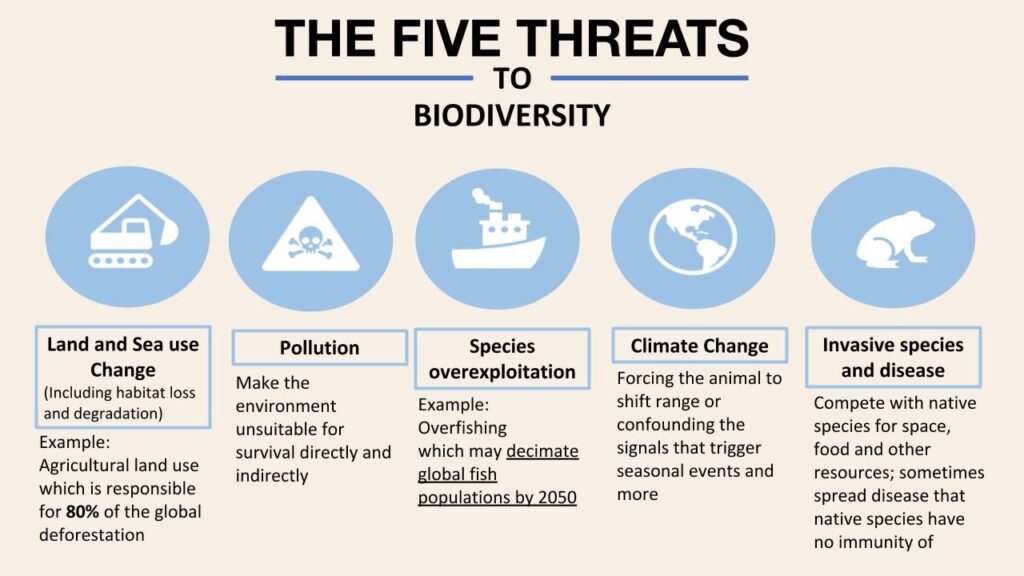You’ve likely heard the term biodiversity. As a popular buzzword in ecological circles, it runs the risk of being overlooked in the grand scheme of things. Because biodiversity refers to an enormous scope — that is, the entire catalog of biological variety within a community or even the world — it can be difficult to conceptualize. Ultimately, rich biodiversity is an indicator of the resilience of the natural world. A greater number of different natural species in an ecosystem correlates to better disease control and preventing the spread of invasive species. The more that species are reduced or eliminated, however, the weaker an ecosystem becomes. With the deleterious forces of climate change, pollution, and species overexploitation, ecosystems are at risk. Cultivating natural landscapes with native plants helps to protect and restore biodiversity.

Biodiversity improves the health of our planet, which, in turn, benefits human health. As a nurse, my training positions me to think critically about health implications in our community. This blog series will first tackle the relationship between biodiversity and chronic health. The CDC reports that chronic diseases are the leading cause of death and disability in the United States (2023), while further research indicates it is responsible for 90% of deaths worldwide (Wallen-Russell et al. 2023). Additionally, approximately 90% of the United States’ $4.1 trillion health expenditures go toward chronic health costs (CDC, 2023). In the United States, 34% of plant species are threatened with extinction, while 41% of ecosystems are on the brink of collapse (NatureServe, 2023). Reduced biodiversity has deleterious effects on human health, including spread of infectious disease, greater exposure to pollution, and poorer quality in nutrition and water (WHO, 2015). Fortunately, a growing body of research finds that improved biodiversity and access to natural green spaces can ameliorate the symptoms of chronic health problems, particularly those related to respiratory and immune system health.
Native plant diversity is necessary for air quality and asthma control. It is easy to witness the effects of worsening climate health on respiratory diseases. In 2019, chronic respiratory disease was the third leading cause of death globally (IHME, 2023). Asthma, Chronic Obstructive Pulmonary Disease (COPD), and emphysema symptoms include coughing with or without phlegm production, shortness of breath, and fatigue, all of which are exacerbated by air pollution. Diverse plant landscapes are adept at mitigating the effects of air pollution and improving local air quality (Aerts, 2018). While nearly all plants have air-purifying qualities, their efficiency depends on the type of plant and their relationship to others in an ecosystem (Vera et al. 2021). Plant diversity can lead to more effective pollutant breakdown and filtration, as different species can absorb and process a variety of pollutants. Native plants are best suited for a community’s climate, soil quality, and moisture levels, and therefore most efficient at acting as a sink for air pollutants (Raj and Singh, 2020). Recent studies indicate that access to greenspaces in urban settings is associated with decreased risk of asthma and reduction in the number of severe cases (Winniki, 2022). Use of native plants is key because many nonnative plants spread through windfall and their pollen can cause allergy symptoms (Wan et al. 2017). Having a diverse native garden also means that pollinators have a variety of plants to choose from, thereby limiting the amount of pollen spread by any one plant (Marinelli, 2007). Through the ability of native plants to purify air, biodiverse habitats set the stage for improved respiratory health.

Native plant diversity promotes an environment’s ideal network of microbiota, which in turn can contribute to a healthy immune system in people. Two biodiversity systems take place to keep us healthy–one in the natural world, and one within our own bodies. Microbes in our airways, gut, and skin regulate our immune system and keep us chugging at homeostasis (Haahtela, 2019). Ongoing research studies have hypothesized that long-term exposure to natural microbes strengthens the immune system and lessens the effect of allergic reactions (2016). This theory is part of the “hygiene hypothesis,” which posits that Westernized cultures tend to over-clean and kill off important microorganisms (2016). Autoimmune diseases, cancer, and depression are associated with inflammatory markers, which are markedly higher in areas with limited biodiversity (von Hertzen, 2011). Similar to the “hygiene hypothesis,” the “biodiversity hypothesis” proposes that loss of plant variety leads to poor immune system outcomes and disease control (Haahtela, 2024). Finnish research indicates that children exposed to biodiverse green spaces were better equipped at preventing autoimmune disorders and allergies (Roslund et al. 2020). Research on microbiota indicates that what affects our outside affects our inside; that is, the microbes found in the natural world feed into the microbiota of our skin (von Hertzen, 2011). When altered, we signal immunity dysfunction in our bodies. Taken all together, we can see that by nurturing native plants, we support a diverse microbial environment crucial for human health.
Native plant diversity and green space accessibility is also important for cardiovascular health. An estimated one in every five deaths is caused by cardiovascular disease (CDC, 2023). Heart diseases, hypertension, and blood clots are considered highly preventable, though we often assume the answer lies within pharmaceuticals. By providing a space to exercise with improved air quality, biodiverse environments improve cardiovascular health at the molecular level. It is well known that greenspaces increase endorphin production and decrease cortisol levels (Roe et al. 2013). This in turn helps manage weight gain and the cardiovascular problems associated with obesity, as well as heart rate and blood pressure. One of the most telling studies available was from Los Angeles and indicated that biodiversity itself had a greater impact on preventing death due to cardiovascular disease than access to greenspaces —in other words, quality over quantity (Giacinto, 2021). The researchers hypothesized that biodiversity improved immune functioning, reduced stress, and limited spread of bacterial disease (2021). While the researchers did not discuss native plants in exact terms, spaces enriched with native plants are biodiversity hotspots that play a key role in the ecological processes that support clean air and water. Integrating native plants into green spaces enhances these areas’ capacity to support a wider range of species, contributing to the overall health and resilience of local ecosystems. From all of this, we might then deduce that native plants are especially well-designed for improving cardiovascular health.
From the research compiled here, biodiversity clearly emerges as a means of protecting human immune health, and therefore protecting us from many chronic diseases. In low-income neighborhoods and communities of color, it is especially important to cultivate biodiversity as a protective feature. Residents are more vulnerable to the effects of climate change and pollution, as well as more likely to develop chronic health diseases (EPA, 2023). Furthermore, these communities are less likely to have native greenspaces and do not experience the benefits of biodiversity. Cultivating native gardens and natural areas has become an emergent matter of public health that we must address.
The data I found was rich in certain areas, but lacking in others. Interestingly, I could not find much data correlating biodiversity with other well-known chronic health diseases, such as Type 2 Diabetes or certain types of cancer. The topic of plants as medicine comes up more frequently in these cases, which I will cover in a later post. I found far more research extolling the benefits of native plants on respiratory and immune health. Suffice it to say, we could benefit from more research that explores the vast world of diverse native plant-life as a balm for chronic disease. I hope going on this health journey with me helps to clarify just how important native plants are for our holistic lives. We require native plants not just to sustain our ecosystem, but our complicated and fragile inner-workings, as well.
About the Series
Native Plants for Healthy People and a Healthy Planet series will explore the importance of strengthening biodiversity resilience by protecting and restoring native plants and natural landscapes. My goal in writing this blog series is to channel biodiversity through a healthcare lens and examine its relationship with human chronic, acute, and mental health. If more people understand how entwined biodiversity is with human health, perhaps policy-makers will take biodiversity resilience more seriously. Native landscapes are vital for improving health outcomes within communities. This series is made possible though the ANHE Environmental Health Nurse Fellowship Program.

The Alliance of Nurses for Healthy Environments (ANHE) is dedicated to connecting nursing and environmental health. They focus on educating nurses, advancing research, and influencing policies to promote healthier people and environments. ANHE recognizes the crucial role nurses play in addressing environmental health issues within communities and at policy levels, aiming to equip them with the necessary knowledge and leadership skills for this challenge.
References
Aerts, R., Honnay, O., & Van Nieuwenhuyse, A. (2018). Biodiversity and human health: mechanisms and evidence of the positive health effects of diversity in nature and green spaces. British Medical Bulletin, 127(1), 5–22. https://doi.org/10.1093/bmb/ldy021
Center for Disease Control and Prevention. (2023, May). Health and Economic Costs of Chronic Diseases. https://www.cdc.gov/chronicdisease/about/costs/index.htm
Center for Disease Control and Prevention. (2023, May). Heart Disease Facts. https://www.cdc.gov/heartdisease/facts.htm
Dunn, R. (2016, May). Letting Biodiversity Get Under Our Skin. Anthropocene. https://anthropocenemagazine.org/2016/05/letting-biodiversity-get-under-our-skin/
Environmental Protection Agency (December 27, 2023). Climate Change and the Health of Socially Vulnerable People. https://www.epa.gov/climateimpacts/climate-change-and-health-socially-vulnerable-people
Giacinto, J. J., Fricker, G. A., Ritter, M., Yost, J., & Doremus, J. (2021). Urban forest biodiversity and cardiovascular disease: Potential health benefits from California’s street trees. PLoS One, 16(11), e0254973. https://doi.org/10.1371/journal.pone.0254973
Haahtela, T. (2019). A biodiversity hypothesis. Allergy, 74, 1445–1456. https://doi.org/10.1111/all.13763
Haahtela, T., Bousquet, J., & Antó, J. M. (2024). From biodiversity to nature deficiency in human health and disease. Porto Biomedical Journal, 9(1), 245. https://doi.org/10.1097/j.pbj.0000000000000245
Hubbart, S. (2022, August 2). Why Biodiversity is Important to Human Health. NEEF USA. https://www.neefusa.org/story/health-and-environment/why-biodiversity-important-human-health
Institute for Health Metrics and Evaluation (IMHE). (2023, April). Global burden of chronic respiratory diseases and risk factors, 1990–2019: An update from the Global Burden of Disease Study 2019. https://www.healthdata.org/research-analysis/library/global-burden-chronic-respiratory-diseases-and-risk-factors-1990-2019
Kafle, A., Timilsina, A., Gautam, A., Adhikari, K., Bhattarai, A., & Aryal, N. (2022). Phytoremediation: Mechanisms, plant selection and enhancement by natural and synthetic agents. Environmental Advances, 8, 100203. https://doi.org/10.1016/j.envadv.2021.100203
Marinelli, J. (2007, April). Create an Allergy-Friendly Garden. National Wildlife Federation. https://www.nwf.org/Magazines/National-Wildlife/2007/Allergy-Friendly-Gardening
NatureServe. (2023). Biodiversity in Focus: United States Edition. https://www.natureserve.org/bif
Roslund, M., Puhakka, R., Grönroos, M., Nurminen, N., Oikarinen, S., Gazali, A. M., Cinek, O., Kramná, L., Siter, N., Vari, H. J., Soininen, L., Parajuli, A., Rajaniemi, J., Kinnunen, T., Laitinen, O. H., Hyöty, H., & Sinkkonen, A. (2020). Biodiversity intervention enhances immune regulation and health-associated commensal microbiota among daycare children. Science Advances, 6, eaba2578. https://doi.org/10.1126/sciadv.aba2578
Vera, S., Viecco, M., & Jorquera, H. (2021). Effects of biodiversity in green roofs and walls on the capture of fine particulate matter. Urban Forestry & Urban Greening, 63, 127229. https://doi.org/10.1016/j.ufug.2021.127229
von Hertzen, L., Hanski, I., & Haahtela, T. (2011). Natural immunity. Biodiversity loss and inflammatory diseases are two global megatrends that might be related. EMBO Reports, 12(11), 1089-93. https://doi.org/10.1038/embor.2011.195
Wallen-Russell, C., Pearlman, N., Wallen-Russell, S., Cretoiu, D., Thompson, D. C., & Voinea, S. C. (2023). A catastrophic biodiversity loss in the environment is being replicated on the skin microbiome: Is this a major contributor to the chronic disease epidemic? Microorganisms, 11(11), 2784. https://doi.org/10.3390/microorganisms11112784
Wan, J.-Z., Wang, C.-J., Yu, F.-H., Wind effects on habitat distributions of wind-dispersed invasive plants across different biomes on a global scale: Assessment using six species. Ecological Informatics, 42, 38-45. https://doi.org/10.1016/j.ecoinf.2017.09.002
World Health Organization. (2015, June). Biodiversity and Health. https://www.who.int/news-room/fact-sheets/detail/biodiversity-and-health
Winnicki, M., Holm, R., Dunn, R. R., Winther-Jensen, M., Jess, T., Allin, K. H., & Bruun, H. H. (2022). Does childhood exposure to biodiverse greenspace reduce the risk of developing asthma? Science of The Total Environment, 850, 157853. https://doi.org/10.1016/j.scitotenv.2022.157853

